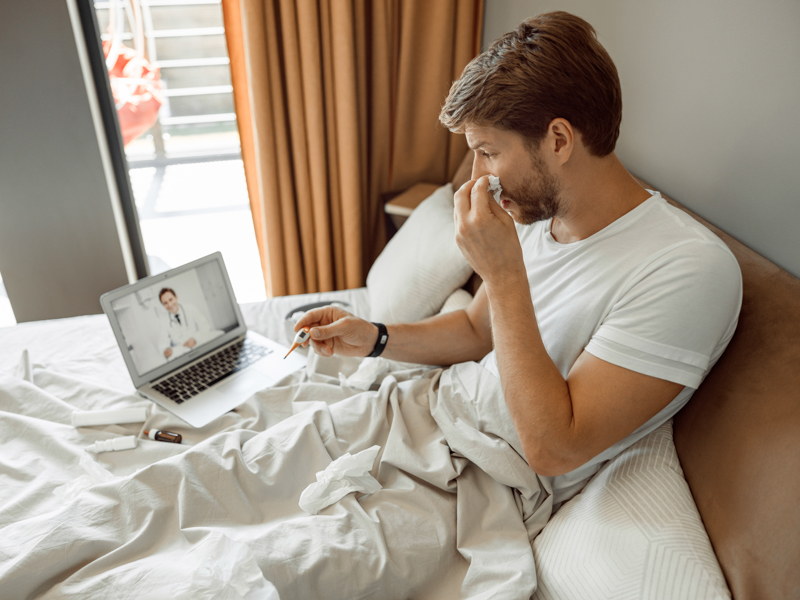Is your home COVID-19 ready? If you're unsure, use these tips

If you or a household member have COVID-19 symptoms or test positive, do you have a ready plan for isolating those infected, protecting vulnerable relatives from transmission, and making sure the sick get the care they need?
Carl Mangum does.
That fact that he’s an emergency preparedness and response expert gives him a bit of an advantage, but Mangum, a psychiatric nurse practitioner and associate professor in the School of Nursing at the University of Mississippi Medical Center, says anyone can use the same skills to prepare in the event the virus infiltrates their household.

“The way you prepare for one disaster is the way you prepare for another,” Mangum said. “The better prepared you are for any emergency or disaster, the better you are prepared for all of them.”
The first step: Separate, isolate and test someone who has symptoms or who has been exposed to an infected person. Identify early on which household members could be most adversely affected.
“My experience in COVID (emergency response) deployment is that you must limit access to the people who are vulnerable,” Mangum said. “These are people who have diabetes, cancer, hypertension, COPD and respiratory issues that are going to be grossly affected by COVID. People want to see grandma and grandpa, but you want to keep them safe and alive.”

Another “now” step: “If you don’t already have a family care provider, see if you can establish one,” said Dr. Bhagyashri Navalkele, assistant professor in the UMMC Division of Infectious Diseases and medical director of Infection Prevention and Control. “You will need to get information from them on what to do if you are diagnosed with COVID-19, what medications to take, and when and if you should go to the emergency room.”
In addition to advice from the Centers for Disease Control and Prevention, Mangum and Navalkele suggest pre-emptive guidance that includes:
- Know where you will get tested, Navalkele said. “You want to make sure you get reliable testing,” she said. “For me, that would either be at UMMC or Mississippi State Department of Health’s Farmers Market testing site.”
- Have on hand over-the-counter and comfort basics such as an oral or forehead thermometer, cough syrup, cold and flu medications, and acetaminophen for fever. “If you can’t have one thermometer that goes into an orifice for each person, then you need to definitely clean it thoroughly after you use it,” Mangum said.
- Designate, if possible, a bedroom with its own bathroom for use exclusively by the COVID-positive person.
“Since the start of the pandemic, I’ve had a guest bedroom in my home designated for isolation,” Navalkele said of her family’s plan. “I have stocked that bedroom and bathroom with essential supplies. I have everything the person who is symptomatic, getting tested, or testing positive needs so that they can stay there for the isolation period.”
If household members must share a bathroom with someone infected, don’t enter it immediately after the infected person exits. “Wait as long as possible, and then go in with a mask on,” Mangum said. “Give the virus time to not be in the air when you walk face-first into it. Run the exhaust fan so that particles can be drawn outside.”
“Clean the bathroom before you use it with bleach or a good cleaning agent. You are killing the virus by wiping it off.” And always, remember to wash hands with soap before leaving the bathroom.
- Come up with a system to communicate needs so that you can minimize entering the person’s room, Mangum said. “You can ring a bell or text,” or use FaceTime or video, Mangum said.
- Make a plan for preparing and delivering meals to the infected person. “Some people like to put a small table or a chair outside the person’s bedroom door,” Mangum said. “They can open the door and grab it.”
Consider getting groceries delivered picked up curbside, Navalkele said. “If everyone in your household tests positive, you might need a family friend to resupply your home,” Mangum said. “Most people don’t have enough milk and bread for the 10 days you’d need to be in isolation.”
Keep meals simple, but make sure the patient has a healthy diet and plenty of liquids, Mangum said. “When you remove their dishes, wash them separately with detergent and hot water,” he said. Place disposable dishes in their own trash bags, empty trash cans in a patient’s room separately from others, and take trash bags to outside cans. Wash hands immediately after handling their dishes and taking trash bags outside.
- If a sick person requires hands-on assistance, wear a mask and gloves, don a gown covering if possible, and place a mask on the patient. “You have to wear a mask, even if you are in your own home,” Mangum said. “If someone is truly sick and running fever, someone needs to check on them, even if it’s just at their door.” Wash your hands immediately after caring for the sick person.
Place the patient’s soiled clothes and linens in a plastic bag and wash them separately. If you have close contact with a patient, wash your clothes separately with hot water and detergent. Although washing your clothes after brief contact might not be necessary, “if you are in their room for any amount of time and they don’t have a mask on, and if you are potentially exposed to (virus) particles, out of an abundance of caution you could wash your clothes immediately,” Mangum said.
- If an infected person experiences difficulty breathing or chest pain, if you can’t awaken them, or if their lips are turning blue, don’t hesitate to call 911, Mangum said. “Just tell them that the person is COVID-positive. They are trained to handle it,” he said.
“Know what emergency room you want to use,” Navalkele said. ”Make sure 911 is on your speed dial.”
Lastly, Mangum said, be positive and encouraging around those who are ill.
“Keep things simple. Don’t make it more work for yourself or your loved one,” he said. “You want them to get better, and you don’t want them to feel like they are a burden on you. Reassure them that it’s OK, and that family takes care of each other.”


